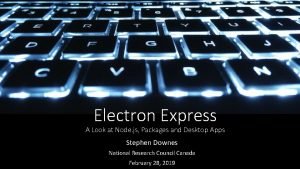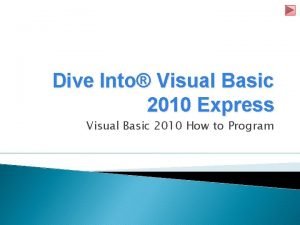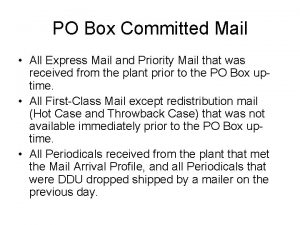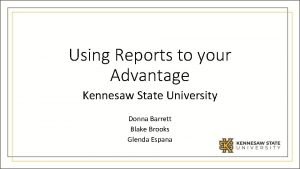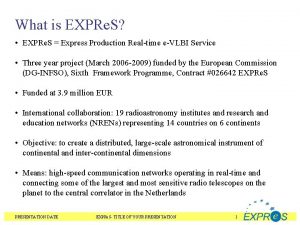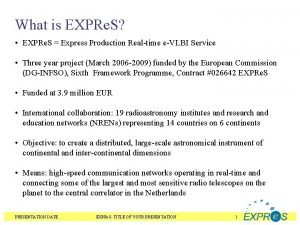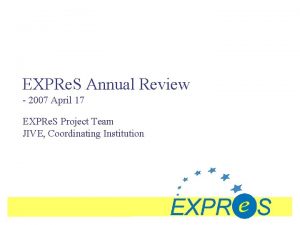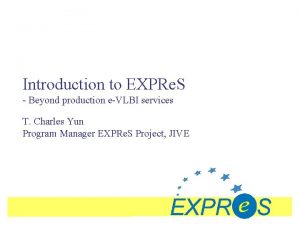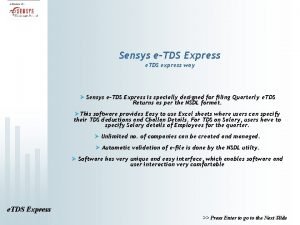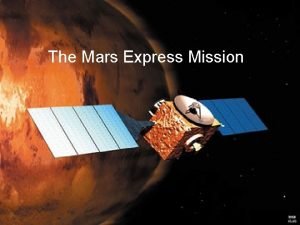What is EXPRe S EXPRe S Express Production












- Slides: 12

What is EXPRe. S? • EXPRe. S = Express Production Real-time e-VLBI Service • Three year project (March 2006 -2009) funded by the European Commission (DG-INFSO), Sixth Framework Programme, Contract #026642 EXPRe. S • Funded at 3. 9 million EUR • International collaboration: 19 radioastronomy institutes and research and education networks (NRENs) representing 14 countries on 6 continents • Objective: to create a distributed, large-scale astronomical instrument of continental and inter-continental dimensions • Means: high-speed communication networks operating in real-time and connecting some of the largest and most sensitive radio telescopes on the planet to the central correlator in the Netherlands PRESENTATION DATE EXPRe. S- TITLE OF YOUR PRESENTATION 1

EXPRe. S Partners 14 Countries, 6 Continents Radio Astronomy Institutes • Joint Institute for VLBI in Europe (Coordinator), The Netherlands • Arecibo Observatory, National Astronomy and Ionosphere Center, Cornell University, USA • Australia Telescope National Facility, a Division of CSIRO, Australia • Institute of Radioastronomy, National Institute for Astrophysics (INAF), Italy • Jodrell Bank Observatory, University of Manchester, United Kingdom • Max Planck Institute for Radio Astronomy (MPIf. R), Germany • Metsähovi Radio Observatory, Helsinki University of Technology (TKK), Finland • National Center of Geographical Information, National Geographic Institute (CNIG-IGN), Spain • Hartebeesthoek Radio Astronomy Observatory, National Research Foundation, South Africa • Netherlands Foundation for Research in Astronomy (ASTRON), NWO, The Netherlands • Onsala Space Observatory, Chalmers University of Technology, Sweden • Shanghai Astronomical Observatory, Chinese Academy of Sciences, China • Torun Centre for Astronomy, Nicolaus Copernicus University, Poland • Transportable Integrated Geodetic Observatory (TIGO), University of Concepción, Chile • Ventspils International Radio Astronomy Center, Ventspils University College, Latvia National Research and Education Networks (NRENs) • AARNet, Australia • DANTE, United Kingdom • Poznan Supercomputing and Networking Center, Poland • SURFnet, The Netherlands PRESENTATION DATE EXPRe. S- TITLE OF YOUR PRESENTATION 2

Participating Telescopes and Network Paths* *Logical network paths. PRESENTATION DATE EXPRe. S- TITLE OF YOUR PRESENTATION 3

EXPRe. S Network Diagram PRESENTATION DATE EXPRe. S- TITLE OF YOUR PRESENTATION 4

Activities # PC NA 1 NA 2 NA 3 NA 4 SA 1 SA 2 JRA 1 Description Leader Project Coordinator Huib Jan van Langevelde, JIVE Management of I 3 T. Charles Yun, JIVE EVN-NREN Forum John Chevers, DANTE e. VLBI Science Forum John Conway, Chalmers Public Outreach Kristine Yun, JIVE Production Services Arpad Szomoru, JIVE Network Provisioning Francisco Colomer, CNIG-IGN FABRIC Huib Jan van Langevelde, JIVE PRESENTATION DATE EXPRe. S- TITLE OF YOUR PRESENTATION 5

What is VLBI? • Astronomy technique: Very Long Baseline Interferometry • A radio telescope looks at an object in the sky and collects data to create an “image” of the source. • Multiple telescopes can view the same object simultaneously. The distance between the telescopes is the baseline. The baseline can be compared to building a single telescope with the diameter of this distance (sort of). • The resolution increases with additional telescopes and longer baselines. • The sensitivity of the image increases with the data collection rate at the telescope. • A central processor decodes, aligns and correlates the data for every possible telescope combination. • Result: images of cosmic radio sources with up to a hundred times better resolution than images from the best optical telescopes PRESENTATION DATE EXPRe. S- TITLE OF YOUR PRESENTATION 6

The science of e-VLBI Aperture Synthesis Imaging Image Credits: Avruch and Pogrebenko • A technique that uses a number of telescopes to simulate a much larger one. A larger dish, real or simulated, improves image clarity and brightness. This requires coordination between the telescopes and a supercomputer. Consider the examples displaying aperture size, aperture distribution and image quality. PRESENTATION DATE EXPRe. S- TITLE OF YOUR PRESENTATION 7

Interferometry Makes a Virtual Telescope PRESENTATION DATE EXPRe. S- TITLE OF YOUR PRESENTATION 8

What is the correlator? • Dedicated, purpose-designed and purpose-built hardware • Synthesis imaging simulates a very large telescope by measuring Fourier components of sky brightness on each baseline pair • Decodes, aligns and correlates the data for every possible telescope combination • EVN Mk. IV data processor at JIVE • custom silicon, 1024 chips • Input data is 1 Gb/s max • Around 100 T-operations/sec PRESENTATION DATE EXPRe. S- TITLE OF YOUR PRESENTATION 9

Interferometry PRESENTATION DATE EXPRe. S- TITLE OF YOUR PRESENTATION 10

What is e-VLBI? • Electronic VLBI • Instead of recording data and shipping disks to the central processor, immediately transport data over networks and correlate it in real-time. • Benefits: - eliminate weeks from the observation & correlation schedule - monitor problems in data collection - detect transient events and schedule near-immediate followon observations - automate observation PRESENTATION DATE EXPRe. S- TITLE OF YOUR PRESENTATION 11

Traditional VLBI vs. e-VLBI PRESENTATION DATE EXPRe. S- TITLE OF YOUR PRESENTATION 12
 Alur proses produksi
Alur proses produksi Printf
Printf Midtown express toll
Midtown express toll Adjectives in spanish
Adjectives in spanish Expressed or implied powers
Expressed or implied powers Modot motor carrier express
Modot motor carrier express Electron run express server
Electron run express server 쉽게 풀어쓴 c언어 express 7장 exercise
쉽게 풀어쓴 c언어 express 7장 exercise Champlain hudson power express project
Champlain hudson power express project Visual studio 2010 express
Visual studio 2010 express American express international inc.
American express international inc. Lux express campaign code
Lux express campaign code Ksu owl express
Ksu owl express






